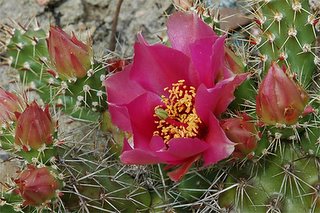The gastropods thrived during the wet weather spell that haunted Denmark a couple of weeks ago – especially black slugs (Arion ater) were abundant in my area. The slugs seem to have a preference for the turgid, succulent leaves of Delosperma nubigenum (Sani Pass, 2900m, Lesotho), grazing off large parts of the plant.
Two black slugs feasting on Delosperma
I don’t know if the slugs don’t find the Delosperma nubigenum flowers palatable or if the attention of the leftmost slug was otherwise diverted. 
A close escape - the flower survives
Anyway, the flower escaped being eaten and I removed the slugs from the plant just after taking the above pictures.
Fortunately the weather has dried up considerably, forcing the slugs and snails into hiding.
Tuesday, August 14, 2007
Black slugs feasting on Delosperma
Thursday, July 19, 2007
New growth and missed opportunities
As mentioned in the previous post the last month has been extremely wet in Denmark. Some of my plants seem to thrive in the humid environment and are setting new growth while the plants just about to flower haven’t exactly rejoiced in the rain.
Last year I planted 4 Opuntia compressa (Monmouth County, New Jersey) seedlings in one of my beds. The plants were started from seed in 2004 (Mesa Garden described the plants as “cold and wet – no problem” in their catalogue, and they are head-on). The new cladodes are still a fresh lime-green and are bearing reddish-brown leaves.
Opuntia compressa (Monmouth Co, NJ), new growth
At the age of 3 the plants are setting their first flowers – I’m hoping for some sun for the flowers to develop properly.
Opuntia compressa (Monmouth Co, NJ) setting flowers
I’ve had my Opuntia 'Smithwick' plant for several years and it never felt like flowering – until now. Unfortunately many of the flowers haven’t fully developed because of the weather and have ended up as “duds”.
Opuntia 'Smithwick' flower buds ready to flower but withered before they got the chance
Still others have been maimed by gastropods (snails, slugs, what have you) wallowing in the rain.
Opuntia 'Smithwick' flower bud maimed by snails
Tuesday, July 17, 2007
Opuntia 'Claude Arno' flowering in the rain
Usually my Opuntias are displaying a wealth of flowers at this time of year, but it’s been raining for weeks now in Denmark, holding the flowers back. The wet weather was preceded by a hot and sunny period resulting in a lot of flower buds; unfortunately many of these will end up as “duds” because of the rain.
Luckily some plants like Opuntia 'Claude Arno' are insisting on flowering even though the chances for being visited by pollinating insects are slim in this weather.
Opuntia 'Claude Arno' flowering in the rain, close-up
Still the plants look pretty miserably in the rain with only half-opened flowers.
Opuntia 'Claude Arno' flowering in the rain
The wet weather has one other unfortunate side effect: hordes of snails and slugs are stampeding through my beds causing havoc for new growth, flower buds, and other tender parts of the plants. The day after the above photos were taken the sun shone, giving the flowers a chance to open fully – to no avail though as most anthers had been shaven off of the stamens, by gastropods I presume.
Opuntia 'Claude Arno' missing anthers
Fortunately I haven’t seen any traces of the Iberian slug (Arion lusitanicus) that has spread up through Europe and is now thriving in the Scandinavian climate to such a degree that it’s nick-named the “killer slug”.
You can find details on other Opuntia plants that flowered in the summer of 2007 in these posts: Opuntia fragilis (Butte Co, Nebraska), Opuntia polyacantha, Opuntia tortispina (Albuquerque, New Mexico).


